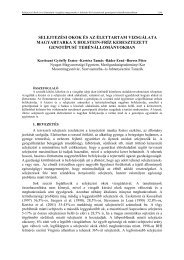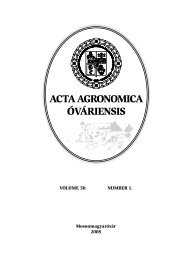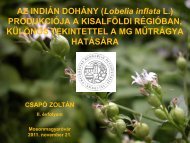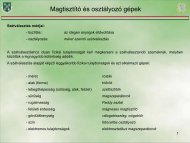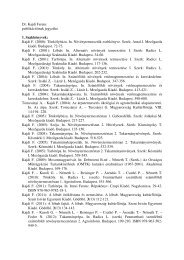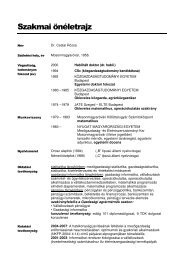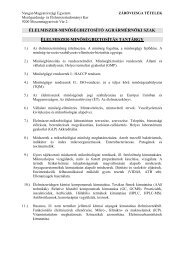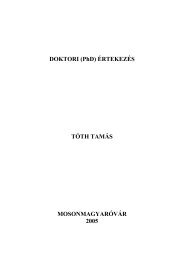teljes anyag - Nyugat-Magyarországi Egyetem Mezőgazdaság
teljes anyag - Nyugat-Magyarországi Egyetem Mezőgazdaság
teljes anyag - Nyugat-Magyarországi Egyetem Mezőgazdaság
You also want an ePaper? Increase the reach of your titles
YUMPU automatically turns print PDFs into web optimized ePapers that Google loves.
In vitro vegetative micropropagation of purple coneflower (Echinacea purpurea L.)11Echinacea species are firstly used by indigenous Americans for the treatment of infections,inflammations, colds, toothaches and snake bites. In view of the efficient results the applicationof coneflower has become general soon (Koroch et al. 2002). In some countriesit’s suitability is also exemined by the treatments of cancer and AIDS.The demand for Echinacea products increased in the end of 1990’s significantly. Currently,medicinal plant products are prepared from field-grown crops (Choffe et al. 2000).Numerous problems exist with preparations that have raised concerns about the quality ofEchinacea products (Consumer Reports 2000).The quality of Echinacea and medicinal plant preparations in general can be seriouslycompromised by contamination of fungi, bacteria and environmental pollutants (Laughlinand Munro 1982), adulteration with the wrong plant species (Betz 1998, Slifman et al. 1998)and considerable variation can be found in the content of medicinally active constituents(Murch et al. 2000).In vitro vegetative micropropagationThe in vitro vegetative micropropagation is one of the sections of plant biotechnology. Itcan be regard as clone-technique, because the organogenesis sets out from somatic cellsso the genotype of descendants is unchanged (Dudits and Heszky 2003).The in vitro propagation is always carried out among sterile and controlled conditions.It’s economical importance that plant materials can be produced in large quantity and inthe same quality in shorter time than by field production.Micropropagation is a complex process, five phases can be distinguished:1. phase of preparation (promoting the success of surface sterilization),2. phase of starting (establishing sterile culture),3. phase of propagation (propagating culture),4. phase of elongation and rooting (lengthening of shoots, inducing of rooting),5. phase of acclimatization (accustoming in greenhouse) (Jámbornéand Dobránszki 2005).MATERIALS AND METHODSEstablishment of sterile cultureThe seeds of purple coneflower can be obtained in commercial trade. After selectinghealthy seeds physical contamination was removed under running tap water. After thatseeds were soaked in 70% ethanol for 1 minute then in sodium-hypochlorite solution for15 minutes. Removal of remains of disinfectant was accomplished by 6–7 rinses withsterile deionized water. Then seed coats were removed and seeds were disinfected againwith sodium-hypochlorite solution. After that seeds were rinsed again with deionizedwater 6–7 times. The surface sterilized seeds were placed in plastic vessels containingMSØ basal medium (Murashigeand Skoog 1962) in a laminar flow bench. The vesselswere sealed and placed into a growth room with 16 hours photoperiod at 22–24 o C for twoweeks. After 14 days 64 seeds weren’t infected from 98 seeds.




